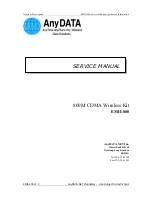
TM106101(8/01)
RDR-1600 Pilot’s Guide
49
Advisory Circulars (Cont.)
48
RDR-1600 Pilot’s Guide
TM106101(8/01)
Advisory Circulars
AC 00-24B
1/20/83
b. Tornadoes.
(1) The most violent thunderstorms draw air into their cloud bases
with great vigor. If the incoming air has any initial rotating motion, it often
forms an extremely concentrated vortex from the surface well into the
cloud. Meteorologists have estimated that wind in such a vortex can
exceed 200 knots; pressure inside the vortex is quite low. The strong
winds gather dust and debris and the low pressure generates a funnel-
shaped cloud extending downward from the cumulonimbus base. If the
cloud does not reach the surface, it is a "funnel cloud"; if it touches a land
surface, it is a "tornado."
(2) Tornadoes occur with both isolated and squall line thunder-
storms. Reports for forecasts of tornadoes indicate that atmospheric con-
ditions are favorable for violent turbulence. An aircraft entering a tornado
vortex is almost certain to suffer structural damage. Since the vortex
extends well into the cloud, any pilot inadvertently caught on instruments
in a severe thunderstorm could encounter a hidden vortex.
(3) Families of tornadoes have been observed as appendages of
the main cloud extending several miles outward from the area of lightning
and precipitation. Thus, any cloud connected to a severe thunderstorm
carries a threat of violence.
c. Turbulence.
(1) Potentially hazardous turbulence is present in all thunderstorms,
and a severe thunderstorm can destroy an aircraft. Strongest turbulence
within the cloud occurs with shear between updrafts and downdrafts.
Outside the cloud, shear turbulence has been encountered several thou-
sand feet above and 20 miles laterally from a severe storm. A low level
turbulent area is the shear zone associated with the gust front. Often, a
"roll cloud" on the leading edge of a storm marks the top of the eddies in
this shear and it signifies an extremely turbulent zone. Gust fronts often
move far ahead (up to 15 miles) of associated precipitation. The gust front
causes a rapid and sometimes drastic change in surface wind ahead of
an approaching storm. Advisory Circular 00-50A, "Low Level Wind Shear,"
explains in greater detail the hazards associated with gust fronts. Figure
A-1 shows a schematic cross section of a thunderstorm with areas out-
side the cloud where turbulence may be encountered.
(2) It is almost impossible to hold a constant altitude in a thunder-
storm, and maneuvering in an attempt to do so provides greatly increased
stress on the aircraft. It is understandable that the speed of the aircraft
determines the rate of turbulence encounters. Stresses are least if the air-
craft is held in a constant attitude and allowed to "ride the waves." To
date, we have no sure way to pick "soft spots" in a thunderstorm.
DEPARTMENT OF TRANSPORTATION
Federal Aviation Administration
Washington, D.C.
Subject
: THUNDERSTORMS
Date
: 1/20/83
AC No.
: 00-24B
Initiated by
: AFO-260
Change
:
1. PURPOSE. This advisory circular describes the hazards of thunder-
storms to aviation and offers guidance to help prevent accidents caused
by thunderstorms.
2, CANCELLATION. Advisory Circular 00-24A, dated June 23, 1978, is
canceled.
3. RELATED READING MATERIAL. Advisory Circulars 00-6A, Aviation
Weather, 00-45B, Aviation Weather Services, 00-50A, Low Level Wind
Shear.
4. GENERAL. We all know what a thunderstorm looks like. Much has
been written about the mechanics and life cycles of thunderstorms. They
have been studied for many years; and while much has been learned, the
studies continue because much is not known. Knowledge and weather
radar have modified our attitudes toward thunderstorms, but one rule con-
tinues to be true - any storm recognizable as a thunder-storm should be
considered hazardous until measurements have shown it to be safe. That
means safe for you and your aircraft. Almost any thunderstorm can spell
disaster for the wrong combination of aircraft and pilot.
5. HAZARDS. A thunderstorm packs just about every weather hazard
know to aviation into one vicious bundle. Although the hazards occur in
numerous combinations, let us look at the most hazardous combination of
thunderstorms, the squall line, then we will examine the hazards individu-
ally.
a. Squall Lines. A squall line is a narrow band of active thunder-
storms. Often it develops on or ahead of a cold front in moist, unstable air,
but it may develop in unstable air far removed from any front. The line
may be too long to detour easily and too wide and severe to penetrate. It
often contains steady-state thunderstorms and presents the single most
intense weather hazard to aircraft. It usually forms rapidly, generally
reaching maximum intensity during the late afternoon and the first few
hours of darkness.








































